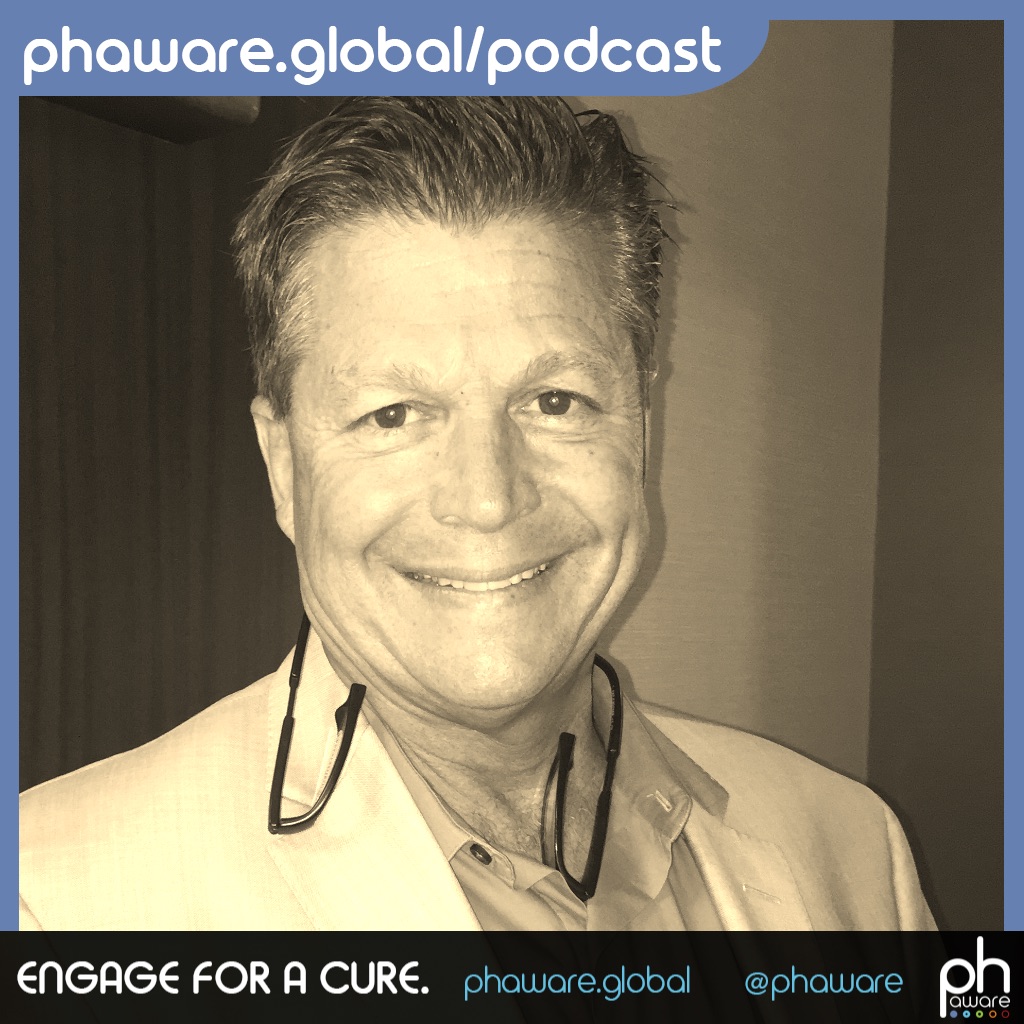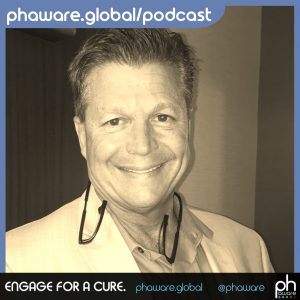Phaware Podcast: Vic Tapson, MD

This podcast series, created and produced by phaware, is being offered as a regular guest feature on Pulmonary Hypertension News to bring the voices and life experiences of PH patients, family members, caregivers, healthcare specialists, and others to our readers. You may listen to the podcast directly, or read it via the transcript that runs below.
I’m Aware That I’m Rare: Vic Tapson, MD
The phaware® interview
Victor F. Tapson, MD, FCCP, FRCP from Cedars-Sinai Medical Group discusses the keys to a proper CTEPH diagnosis. Dr. Tapson also talks about the importance of the CTEPH National Proceedings Conference taking place 11/9-11/10 at UCSD. www.cteph2017.com Dr. Tapson has devoted his medical career to patient care, research, and teaching in pulmonary hypertension (PH) and pulmonary embolism.
I’m Vic Tapson. I’m in pulmonary critical care, and I’m at Cedars-Sinai Medical Center of Los Angeles.
Having been interested in pulmonary hypertension for many years now, and actually pulmonary embolism, this was kind of a combination of my two favorite subjects. CTEPH, or Chronic Thromboembolic Pulmonary Hypertension, is an area that has  been dominated by great work that UC San Diego has done and a few other centers around the world.
been dominated by great work that UC San Diego has done and a few other centers around the world.
So, the meeting here today is one with a lot of experts here, a lot of great lecturers. We’re trying to advance this field of CTEPH, to learn how to mainly make people more aware of this disease. Not just lay people and community, but physicians. Physicians miss this diagnosis, it’s hard to read on CT scan. So, you order a CT for something and people might think, “Oh, there’s so scarring in the lungs” but they may not diagnose the actual clot. So, this is a significant cause of pulmonary hypertension, and one of the really important things about it, it’s one of the few curable causes of pulmonary hypertension. So, awareness is a big deal. We have new drugs for this disease, which is FDA-approved, for treating this disease. That drug doesn’t take the place of surgery, but it’s a very important drug for patients who either can’t get surgery, or have surgery and still have some residual pulmonary hypertension.
One of the topics I was asked to talk about was something called vena cava filters, or IVC filters. These filters we put in patients that have acute pulmonary embolism. Blood clots in the lungs are acute, especially if they have reasons we can’t put them on a blood thinner, or they have recurrent clots in spite of being on a blood thinner. But there isn’t great data on when to use these, and in CTEPH it’s been pretty much the standard of care. When someone’s diagnosed with CTEPH, not only are they anticoagulated and considered for surgery, but we usually we put an IVC filter.
We had a nice debate discussing the pros and cons. We don’t have a lot of data saying these filters ought to be put in, but they make us feel more comfortable. You put this filter in the vena cava, if a clot does form in a leg, you can’t get to the lung. So, most of us I think are pretty comfortable that the benefit outweighs the potential risk of procedural complications, filter clotting, things like that. So, it was kind of an exciting debate, we had good discussion, and the entire meeting has been that way. It’s been discussions, debates, areas where we don’t have a lot of data. Discussions by experts who have been doing this for many years, that have opinions one way or the other, and we share opinions, we try to come to conclusions.
One of the other great things about this meeting is, just getting ideas for future studies, future things we need to do. Whether it’s finding ways to raise awareness, or whether it’s designing new studies that can be done. So, it’s been very exciting.
CTEPH challenges
There’s a lot of challenges with CTEPH, as well as with other forms of pulmonary hypertension. Patients often have acute pulmonary embolism, they’re treated with a blood thinner, they’re followed for a period of time. Often the blood thinners stop, they go about their business, and then in a small percentage of cases, but a small percentage in a setting of a lot of pulmonary embolisms, I mean hundreds of thousands of cases of acute PE every year in the US. So that’s kind of a setting, but only a small percentage get CTEPH, but because there’s so many, we think it’s a big number.
So, how do patients get to us? They usually get more short of breath, kind of like a patient with PAH might develop shortness of breath, or more chronic shortness of breath worsening. Someone finally figures out they have PH, and then they go by our rule, we hope, and get a V/Q scan and figure out this is very likely CTEPH. So, physicians have to recognize this and that’s one of the problems with it. The two key things are identify whether there’s pulmonary hypertension or not, and identify whether it’s caused by clotting. Sometimes you identify the Pulmonary Hypertension first, sometimes you identify the clot problem first. You may do a CT scan in someone short of breath, find out they have chronic pulmonary embolism, and they’re short of breath enough that you go ahead and get an ECHO. You find suggestions of pulmonary hypertension, and you get a CATH and prove it.
Or, you might find someone with PH, you’ve done the ECHO, you’ve done the CATH, you know they have PH, and then you say, “Well, could this be clots?” You do a lung scan and find out in fact that it is. So, you kind of come either way, to diagnosis but it’s a tough diagnosis. I have a lot of admiration for the surgeons that do what we call PTE surgery, or sometimes called PEA, pulmonary endarterectomy surgery. It’s a complex operation that takes time. The key of course, identifying the right patients, making sure they are what we call operable. We believe many, if not most, of these patients are operable.
A surgeon has to go in there, and this is a procedure done on bypass. What they’re trying to do is not just get the clot out, like we might find in acute pulmonary embolism, but are trying to get scar tissue out. These clots over time retract and form this fibrous scar on the vessel, so when they get in there, and they look in the vessel, they have to find a dissection plane, find it where this abnormal vessel starts, and then once they start dissecting, go down and pull this clot out. So, unlike just plucking a clot out, with acute pulmonary embolism, they’re in there dissecting and digging, this procedure is hours and hours long. It takes a very skilled and patient surgeon.
The first thing we recommend if someone is deemed not a candidate, it’s got to be that they were deemed not a candidate by an expert center. If that’s what they say at UC San Diego, that’s the word. If it’s a big center — Duke, UC San Diego, Mass General, Cleveland Clinic — where they do a lot of procedures. That’s going to be the final word. Maybe a smaller center, less experience, if they say this is an inoperable patient, you probably ought to get a second opinion. Talk to the guys in San Diego, or send the information out. Make sure they’re not operable.
Then, if they’re not operable, then we go to medical therapy. We’ve used all kinds of medical therapy for PH. Now we’ve got data and FDA approval for a drug that really works here. The reason it works is because this disease is not just clots, scars. These area is what we call smooth muscle proliferation and arterial disease independent of clots. It forms in areas of the lung as a reactive, a reaction to the clot in the lung, to low oxygen levels, etc., and you get this narrowing and constricting of these blood vessels. Frankly, it’s great that even in patients who are inoperable, or who those few that have pulmonary hypertension left after surgery, that pressure can still come down.
It’s very satisfying to see these patients come out, it’s a big operation, to see them come out, recover, get out of the hospital maybe in a week or whenever they get out. They’ve got to be seen in the clinic fairly soon, in a couple of weeks, to make sure there’s no post-operative problems, they’re healing well, there’s no pericardial effusion, no evidence of a blood clot in their leg, etc. The key is get them through the surgery. Make sure their diuresed well enough. Make sure their oxygen level’s OK, make sure they’re healing well, and then I’ll tell you, they’re on the road to recovery. It’s very satisfying.
Less patients are inoperable than were 10 years ago, at a good center. We’re learning more about whether we should put IVC filters in or not, we have to study these types of things. Operative techniques have improved, medications have improved, post-op care has improved and it’s a team effort. It’s Nursing, Pulmonologists, Cardiologists, Surgeons, Physician’s Assistants, Nurse Practitioners, Anesthesiologists. It’s a real team effort, it’s very satisfying. These meetings are multidisciplinary meetings, so I come as a pulmonologist and I know a lot of pulmonary medicine, but I’m learning from cardiologists and surgeons and anesthesiologists. So, I love that multidisciplinary aspect of this disease.
I’m Vic Tapson and I’m aware that I’m rare.
EVERYBODY HAS A STORY. WHAT’S YOURS?
Phaware global association wants to share your pulmonary hypertension story with their engaged global audience. Whether you are a patient, caregiver, or medical professional, they are enlisting PH community members from around the world. Visit www.phawarepodcast.libsyn.com/contact to share your story and to be considered for a future episode. Never miss an episode with the phaware® podcast app. Learn more about pulmonary hypertension at www.phaware.global. #phaware
***
Note: Pulmonary Hypertension News is strictly a news and information website about the disease. It does not provide medical advice, diagnosis, or treatment. This content is not intended to be a substitute for professional medical advice, diagnosis, or treatment. Always seek the advice of your physician or other qualified health provider with any questions you may have regarding a medical condition. Never disregard professional medical advice or delay in seeking it because of something you have read on this website. The opinions expressed in this column are not those of Pulmonary Hypertension News or its parent company, Bionews Services, and are intended to spark discussion about issues pertaining to pulmonary hypertension.










Leave a comment
Fill in the required fields to post. Your email address will not be published.